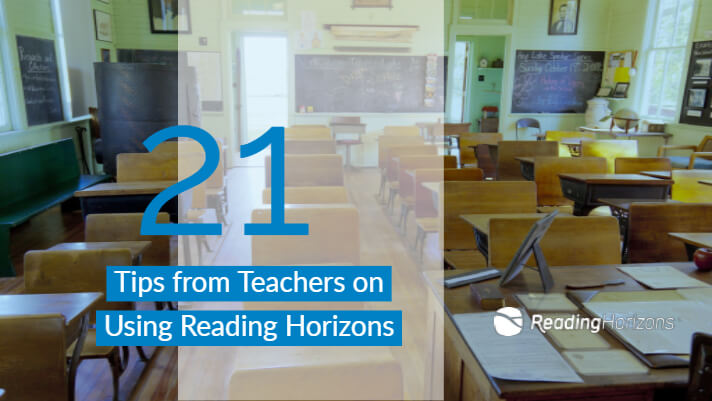
Earlier this year we asked for teaching advice from members of the Reading Horizons Teachers League. If you have ever implemented a new reading curriculum, then you know that some of the techniques you were taught during training don’t always work with each student. For that reason, we asked for teaching advice. We received many great responses and have compiled a list below of 21 easy-to-implement tips on teaching Reading Horizons in your classroom:
- Excitement is contagious. If you show excitement for what you are teaching, engagement will be there, and learning will take place. – Emily Y.
- Immerse your students in text, and give them lots of opportunities to practice what you have taught. – Dana F.
- Giving students a safe practice zone where they feel comfortable being wrong is very important to their success! When they feel comfortable making mistakes, they’ll feel comfortable asking questions, and that’s when the real learning begins! – Kera J.
- Always take time to reflect on each lesson. Be intentional and be prepared! – Aimee W.
- Throw in a few games for review. The kids love them, and it reinforces what you are teaching every day! – Nicole G.
- Always utilize the transfer cards. We have the students play teacher, and they love it! – Casey B.
- You are going to be amazed at the growth your students will make throughout the year! Please don’t give up or alter the lessons. Your students will benefit from each lesson! – Ranae S.
- Repetition and routine are important, but mixing it up keeps things fresh. There are so many options for games and activities to give students the practice they need as well as keep the program engaging. – Stephanie S.
- We use our whiteboards a lot to prove words, so I hot glue a pom-pom ball at the end of the dry erase marker for them to use as an eraser. – Amy H.
- Use letter tiles to practice making slides, words, and nonsense words during small group instruction. – Suzan M.
- Use Unifix Cubes in two different colors (vowels and consonants) so that students can visually see the difference. CVCs will be easier to introduce in the future. – Paula S.
- I have started to recognize students who use the skills they have learned during Reading Horizons outside of Reading Horizons instruction by referring to them as “Reading Horizons Experts.” My students are constantly looking to find the most recent skill we are focusing on throughout the day. It has really helped them make connections! – Randi W.
- Stay consistent with the use of Reading Horizons! Give specific feedback regarding lesson progress. As I work with adults, I open the library so that they can read whatever interests them. I also increase the number of vocabulary words for my adult English Language Learners. We <3 Reading Horizons! – Arlene H.
- Take your time. When starting, just take it one day at a time. The program proves itself if you follow it. – Katie D.
- Identify all four steps in each lesson and stick to them! (Review, learn something new, dictate, and transfer.) Keep the kids accountable, and keep the lesson moving for best classroom control. Do not reteach during dictation; have them look to their friends. – Kelly K.
- Be consistent with teaching, encourage students to complete lessons online with a reward online, and shoot for 90 percent mastery. – Courtney
- I have created small flashcards based on the skill we are working on. The students can work on these individually, in small groups, or one-on-one with me. The purpose of this activity is to increase their fluency automaticity of reading whole words. – Stacy A.
- Going to the web training was so valuable! It really helps to remember the details! It also helps to practice with peers. – Ann L.
- When starting the program, don’t give up! Keep going. The flow of the curriculum comes with daily repetition and practice. If you are still not sure of what to do, ask someone! Keep going! It will get easier. 🙂 – Amanda B.
- Utilize the provided resources, the games, online apps, etc., to make the session fun and educational. My students beg to play “Panic!” and some of the other games. Also, let them partner with the transfer cards and teach each other. Great stuff! – Cindy K.
- The transfer cards are extremely beneficial for further developing fluency and transfer of phonetic skills to everyday reading. Also, the use of sand trays to tie in additional multisensory instruction helps too. – Lynn D.
What do you think? Did we miss anything? If you have any other teaching tips, let us know in the comments below. Also, if you would like to be included in other surveys, click here or join our Facebook group, Reading Horizons Teachers League.
